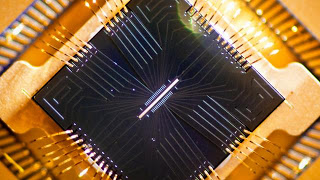

| Visitors Now: | |
| Total Visits: | |
| Total Stories: |

| Story Views | |
| Now: | |
| Last Hour: | |
| Last 24 Hours: | |
| Total: | |
Scaling Ion Trap Quantum Computers to Thousands of Qubits
From
Ion trap technology are a scalable option for quantum computers.
Trapped atomic ions are a promising architecture that satisfies many of the critical requirements for constructing a quantum computer. At the heart of quantum computers are qubits, systems maintained in two or more quantum states simultaneously. Here, the qubits are manifested in the internal energy levels of the ions, and are manipulated through laser and microwave radiation. These technologies are a key factor in the success of atomic ions: scientists can set the frequency of the radiation to match that of the ion’s energy level spacings with extreme precision.
The qubits have long coherence time — meaning they can be placed in quantum states and remain that way long enough to perform calculations. The qubit’s states are not sensitive to ambient disturbances like magnetic fields, giving them inherent protection from the destructive environment.
Monroe and Kim are part of a larger collaboration called MUSIQC, which stands for Modular Universal Scalable Ion-trap Quantum Computer, and is supported by the Intelligence Advance Research Projects Activity (IARPA).
Surface trap fabricated by Sandia National Labs, supported by IARPA. This type of trap has been used to capture ions at JQI and Duke University, as well as other institutions. The image shown here appears on the cover of this week's issue of Science Magazine. Credit and permissions, contact JQI
Science – Scaling the Ion Trap Quantum Processor
See more and subscribe to NextBigFuture at 2013-03-07 18:02:00 Source: http://nextbigfuture.com/2013/03/scaling-ion-trap-quantum-computers-to.html
Source:



